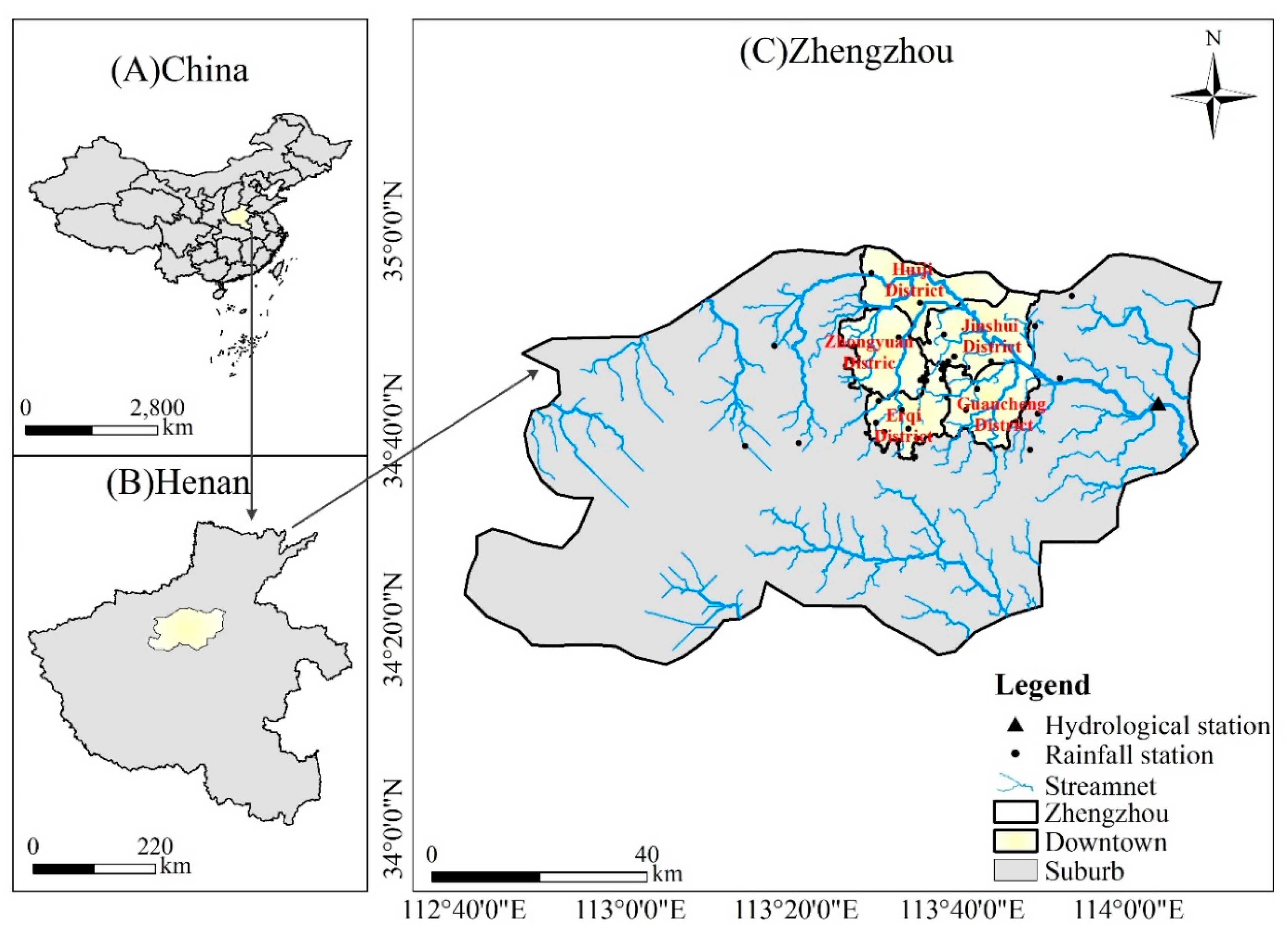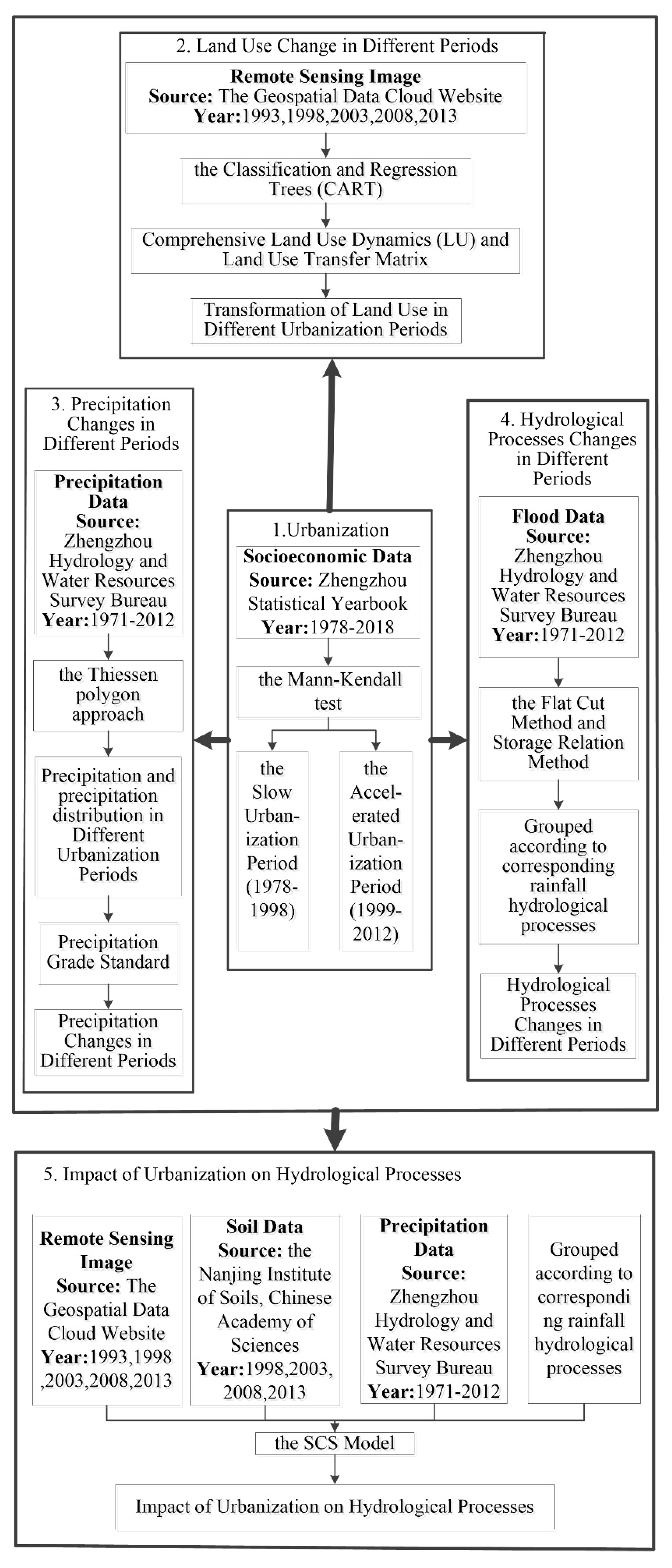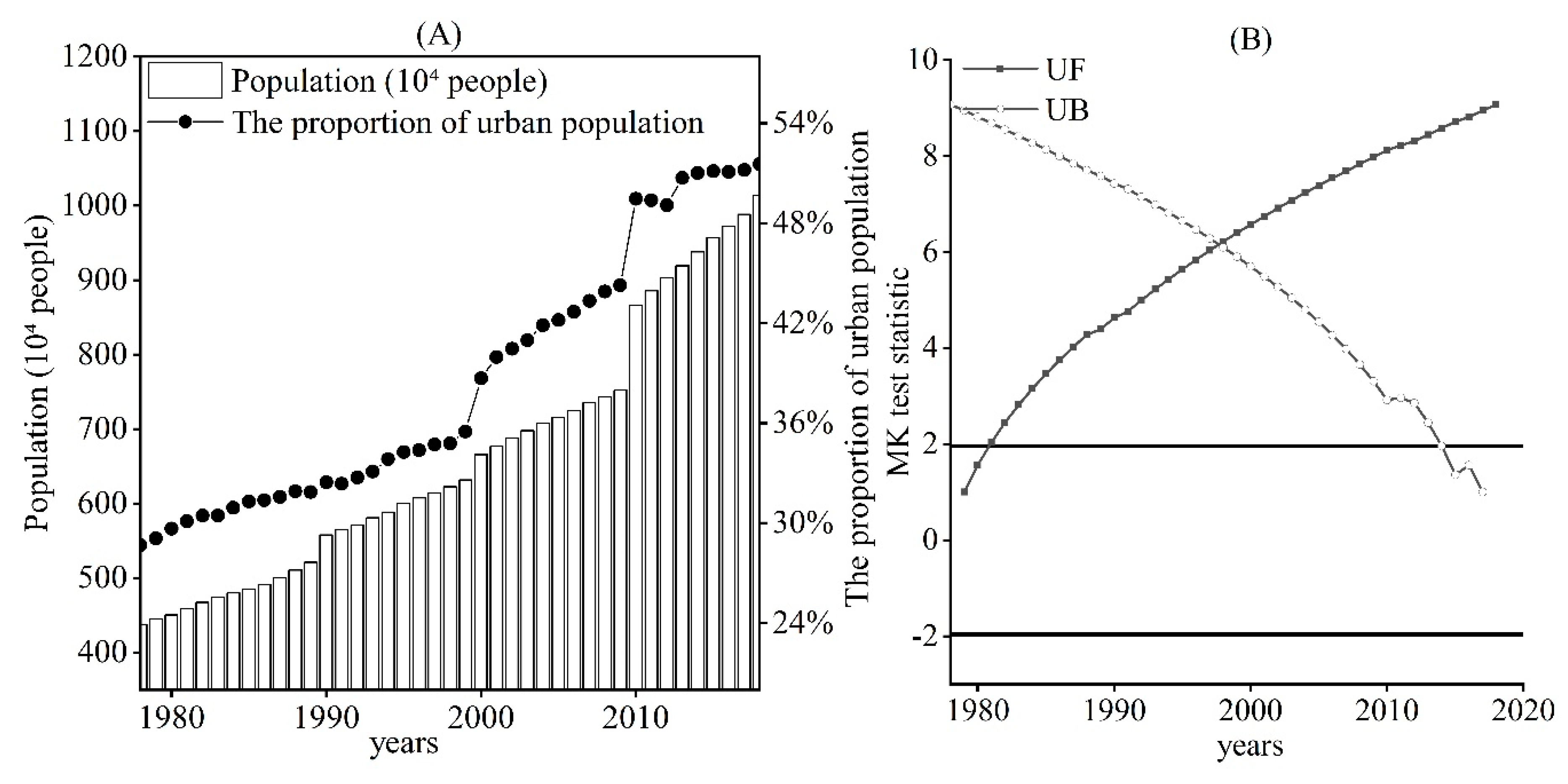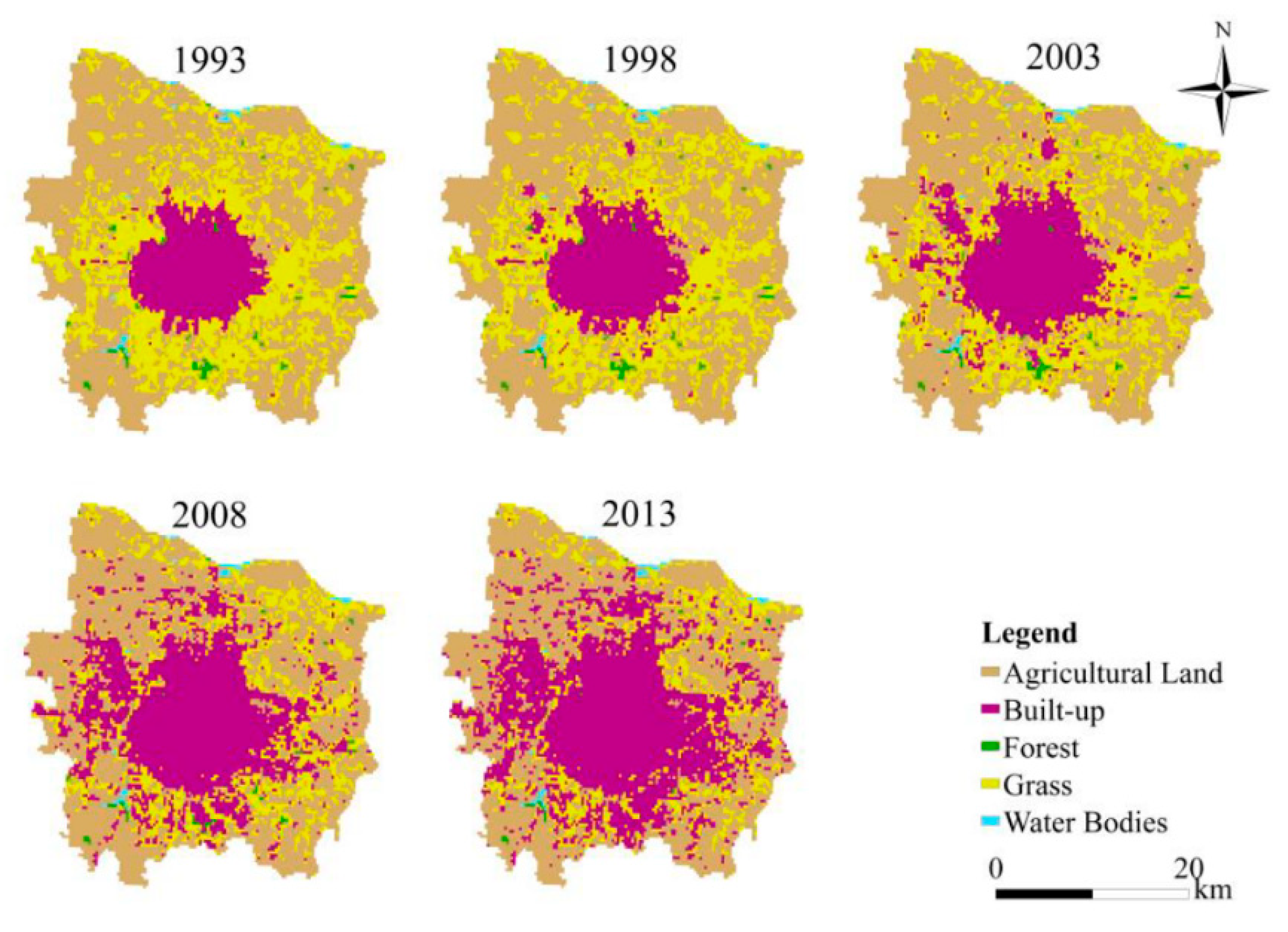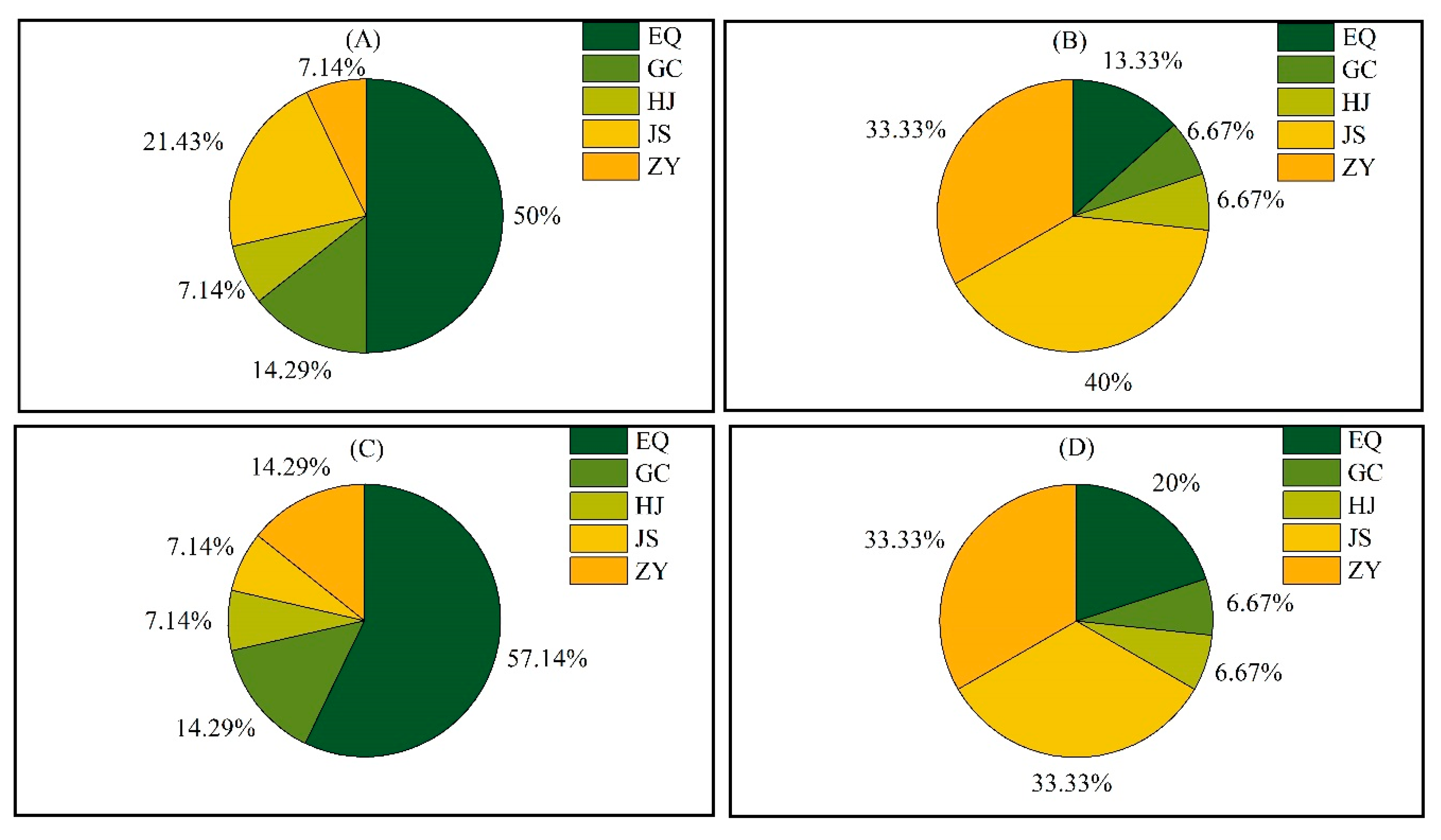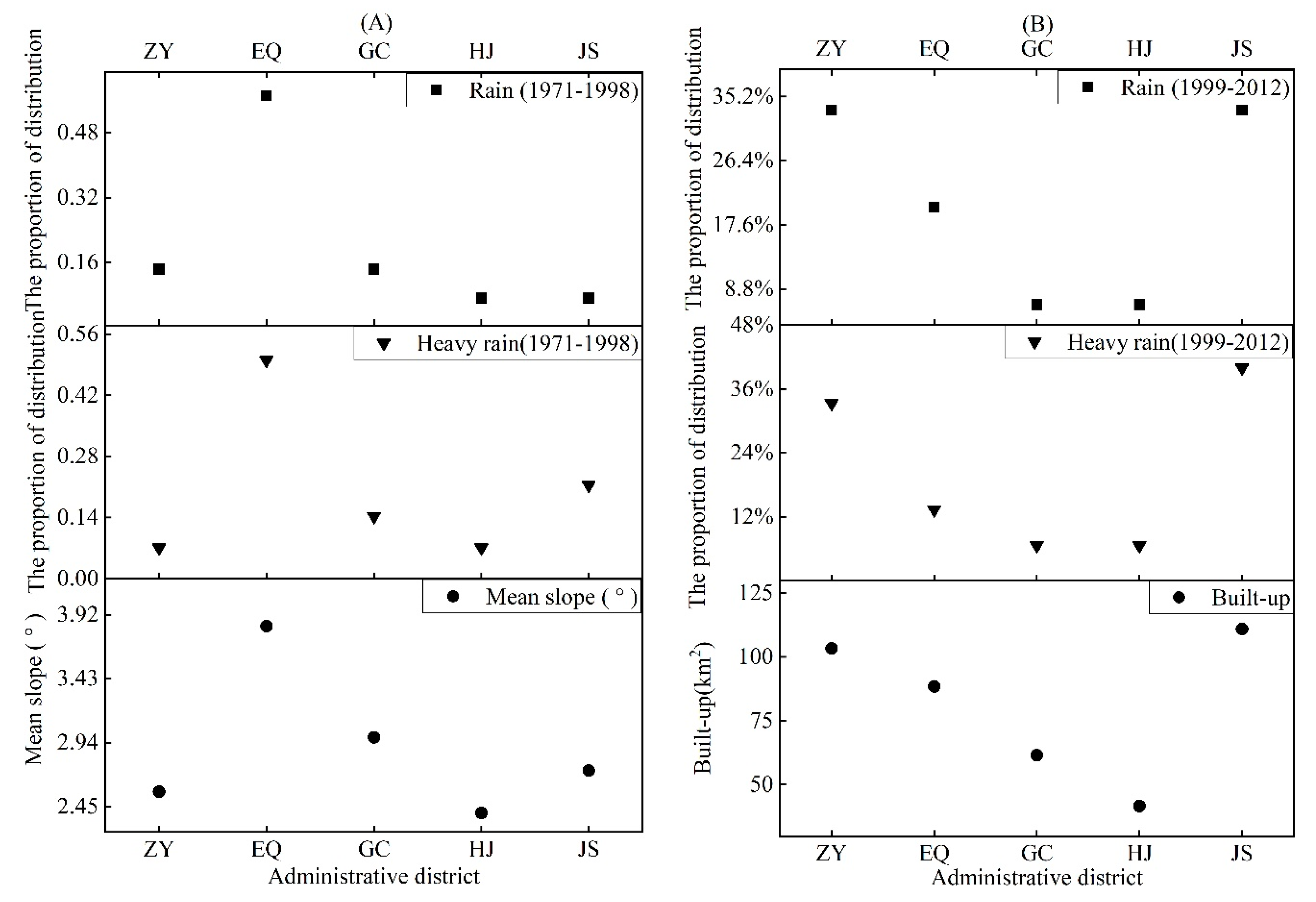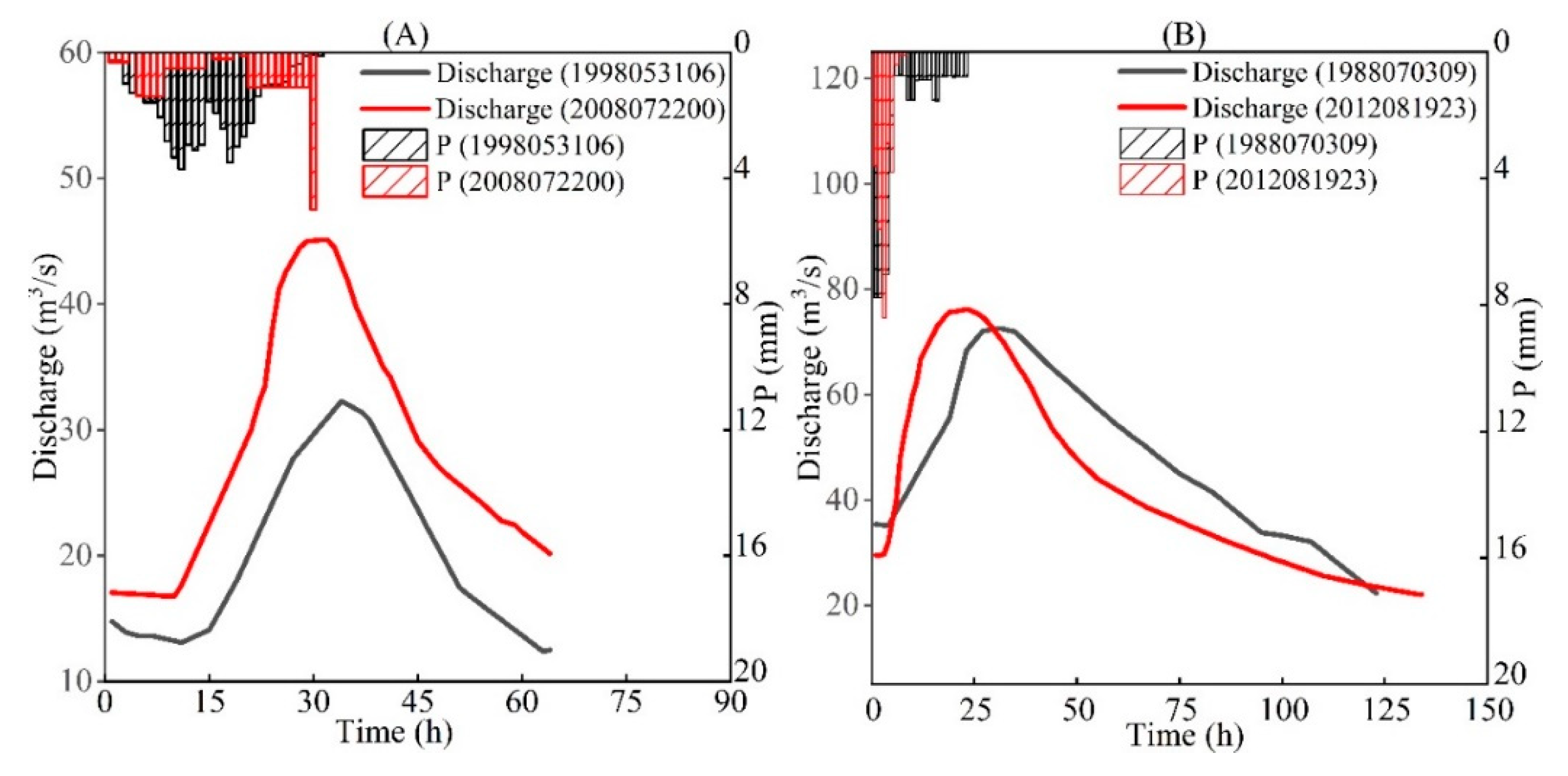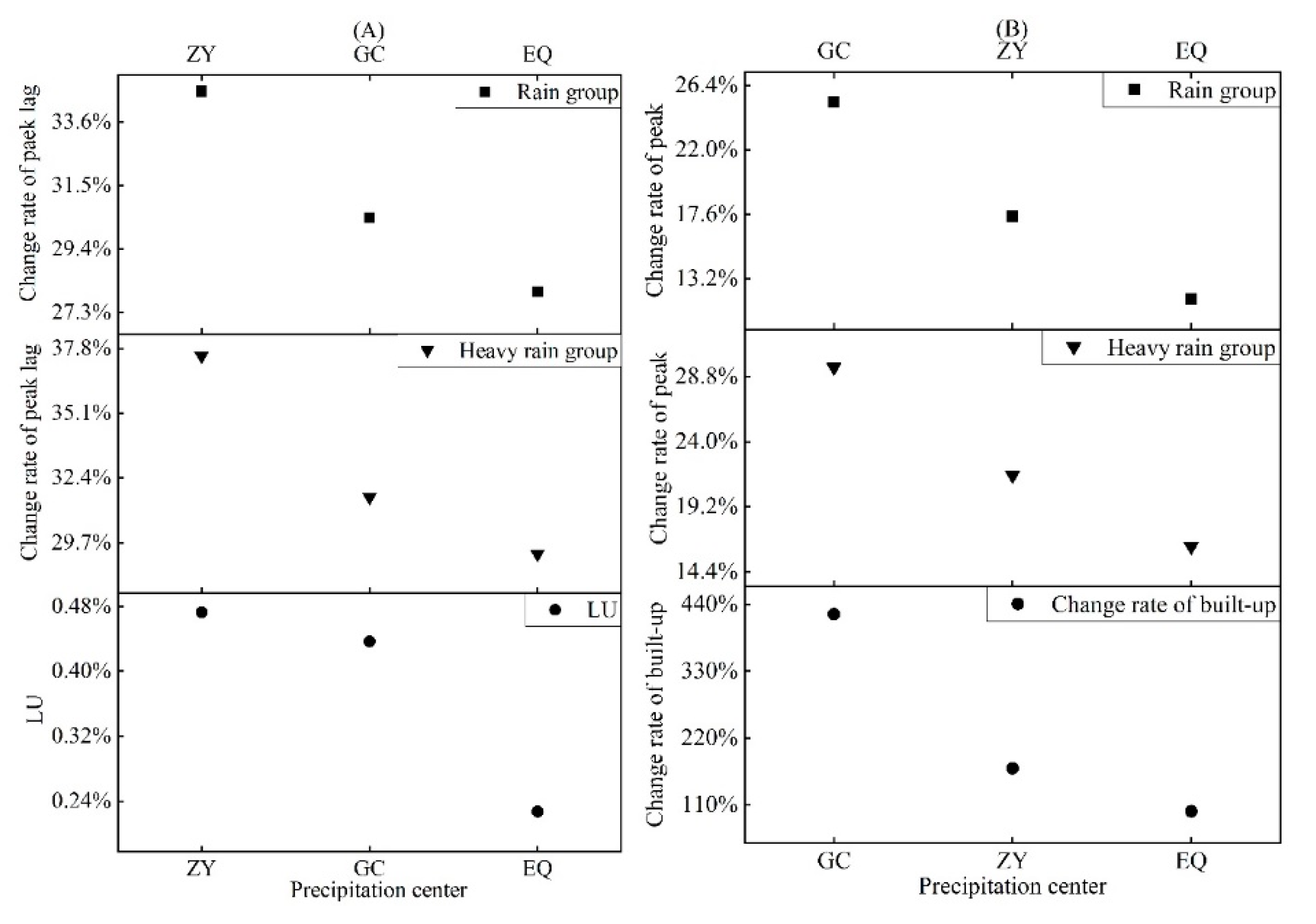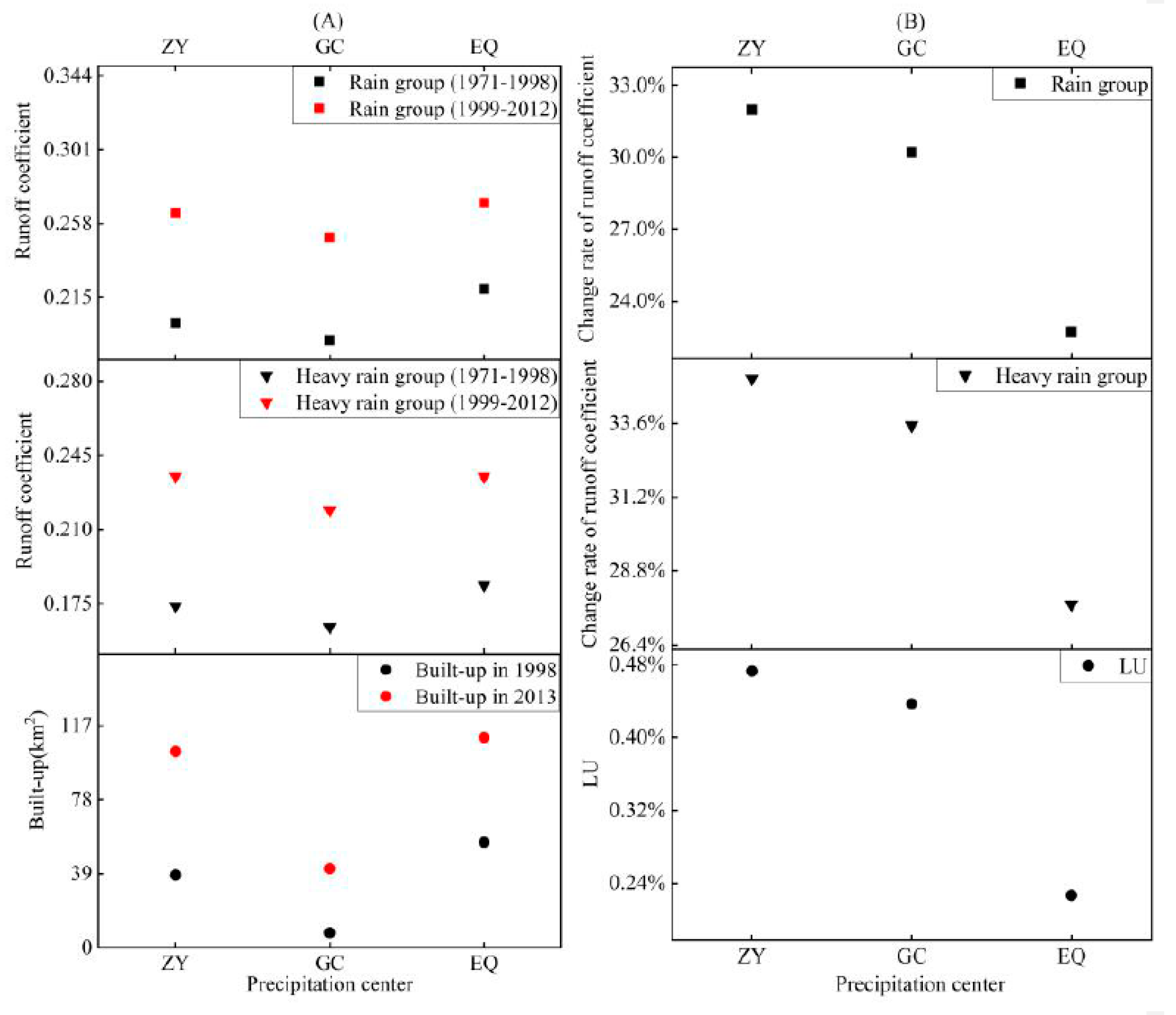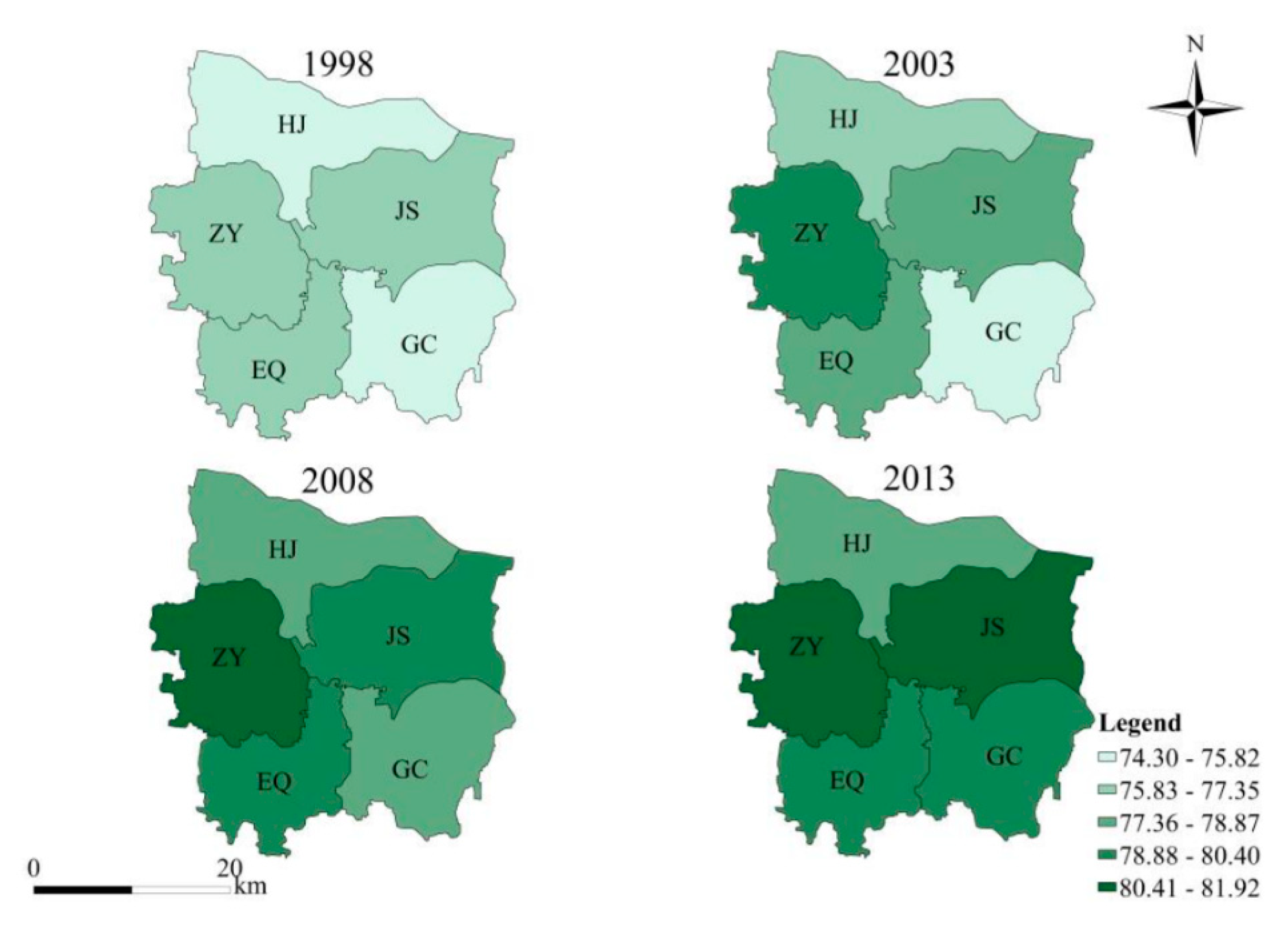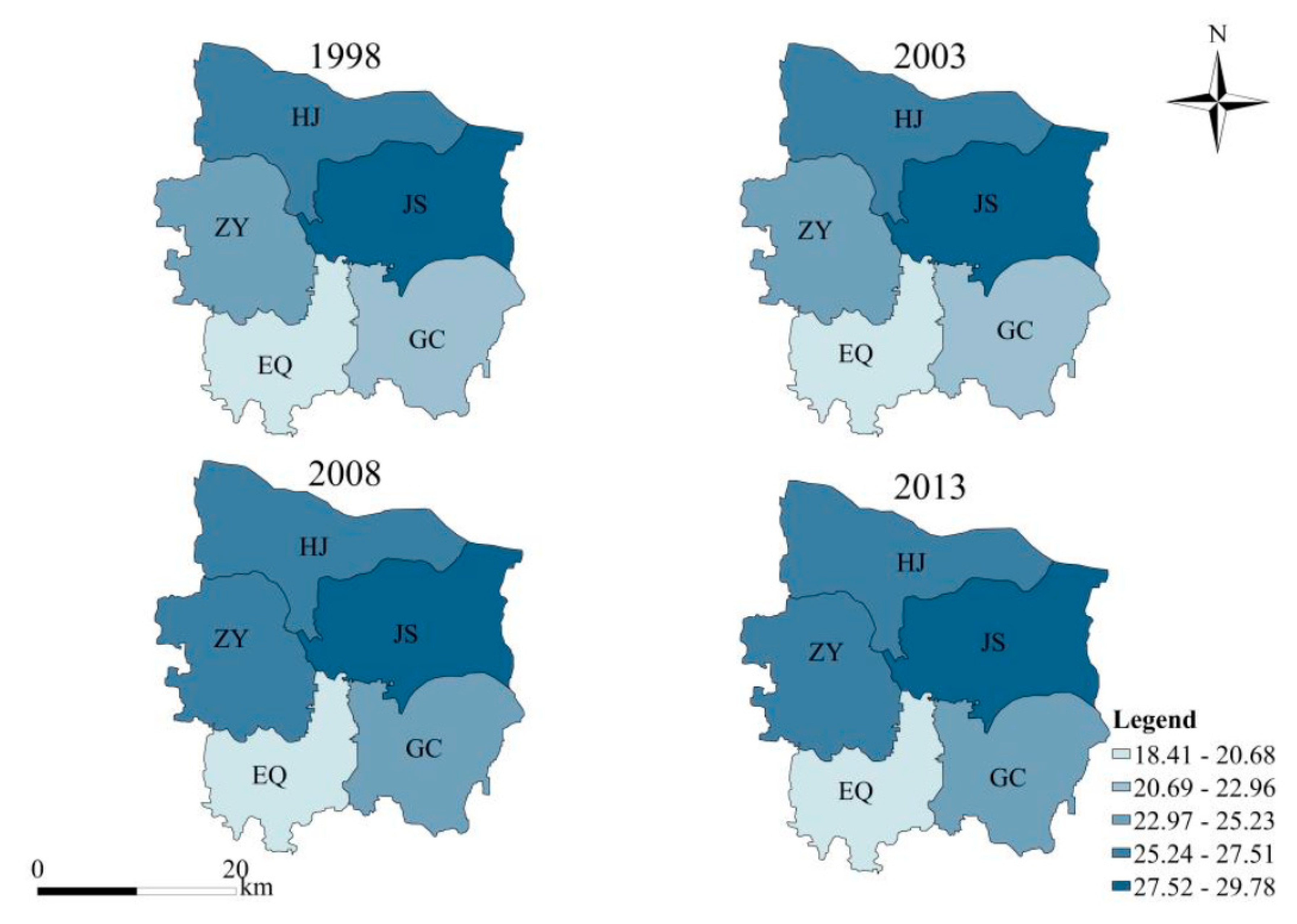1. Introduction
Significant changes have taken place in the urban hydrological process [
1,
2], such as the increase of peak and the reduction of water degeneration [
3], and the increase of surface runoff [
4]. The causes of urban hydrological process change mainly focus on two aspects. One is the impact of climate change. The mechanism of the impact of climate change on hydrological processes is relatively clear [
5,
6,
7]. Many studies have shown that climate change altered regional hydrological conditions [
8,
9], and cities amplified the hydrological changes of natural watersheds [
10,
11]. Another is the impact of urbanization. Land use changes related to urbanization change rainfall-runoff generation processes in complex ways [
12,
13,
14]. In the process of urban development, urban resources (population, impermeable surface, building density, green space, etc.) are disproportionately distributed within urban areas. Hence, the rainfall-runoff relationship become more complex and highly non-linear depending on changing rainfall time-space distribution and land-use [
15,
16,
17,
18,
19]. Saifullah et al. [
20] found that the impact of land use change on runoff process is increasing with urbanization, so it is of great significance to analyze the impact of land use change on runoff process in combination with the characteristics of the urbanization process, which is helpful to cope with the changes of the hydrological process after urbanization and improve the city’s flood control ability and protect urban security.
Urban expansion changes the natural underlying surface condition [
21,
22], which affects the catchment characteristics [
23,
24,
25]. The expansion of built-up areas disturbs the original vegetation cover, reducing the amount of penetrations and increasing the amount of runoff [
26,
27,
28]. Based on this, many studies took impervious surface as the main index to analyze the impact of land use change on hydrological process, and found that combinations of impervious surface and spatial rainfall patterns enhance hydrological responses [
29,
30,
31]. However, the relationship between rainfall-runoff is highly non-linear and complex [
32,
33,
34,
35], the use of impervious surface to analyze the impact of land use change on runoff process has limitations. Further research is needed on the impact of land use changes on runoff processes caused by urbanization. Li et al. [
36] assessed the relative influence and marginal effects factors affecting direct runoff using boosted regression trees, and the results showed that the runoff had the strongest correlation with rainfall, followed by impervious surface, normalized difference vegetation index, antecedent 5-day rainfall. Sertel et al. [
10] applied the Soil and Water Assessment Tool (SWAT) distributed hydrological model to the Buyukcekmece Basin of Istanbul metropolis to analyze the sensitivity of hydrological elements to land use. Infiltration, evaporation, and basal flow are the most sensitive to land use, while soil water is the least. The above studies show that urbanization affects the distribution of temporal characteristics of rainfall and hydrological processes. However, there is limited understanding of rainfall and runoff sensitivity to the rapidly development of urban.
Zhengzhou is an ideal research area to study the effects of urbanization on hydrological processes. On the one hand, compared with other rapidly developing cities, Zhengzhou has a network of rain stations and hydrological stations established earlier, which is convenient to obtain rainfall data and hydrological data. On the other hand, the urbanization of Zhengzhou is typical. In recent years, driven by a series of development policies, such as reform and opening-up and the construction of the Central Plains urban agglomeration, Zhengzhou is in the process of rapid urbanization, with a rapidly expanding urban area and obvious imbalance of development among regions [
37]. As a result, the impact of urbanization on the hydrological process is increasingly obvious, and many researches are concentrated here. Based on the Landsat remote sensing images to extract the land use and water system structure of Zhengzhou in 1988, 2002, and 2016 with RS and GIS, Wu [
38] found that the reduction of river network in Zhengzhou urbanization area led to the decline of the capacity of the water system through analyzing the changes of Zhengzhou water system structure and the capacity of the water system structure with river length, water area, river network density, water surface ratio, water system connectivity, storage capacity, adjustable storage capacity, unit storage capacity per unit area, and adjustable storage capacity per unit area. It is necessary to adopt low-impact development (LID) to meet Zhengzhou’s requirements for urban rainfall and waterlogging. The runoff data selected for the studies of the impact of Zhengzhou urbanization on the hydrological process are mostly runoff data from the Zhengzhou section of the Jialu River Basin. Wang et al. [
39] found that 2009 was the mutation point of runoff coefficient through the Mann–Kendall test of runoff coefficient during 1995–2015. The multi-year average of runoff coefficient from 1995 to 2009 was 0.21, and the average value increased from 2009 to 0.28, with an increase of 33.33%. It was found that the land use change in Zhengzhou caused the runoff coefficient to develop to a high value through simulating the annual rainfall and runoff data of Zhengzhou section of the Jialu River Basin from 1995 to 2015 with the SCS model and analyzing the land use, which was one of the main reasons leading to the increase in total runoff. Liu [
40] found that land use change had the greatest impact on runoff in dry years by analyzing the annual runoff process in wet years (10%), normal years (50%), and dry years (90%) with the hydrologic statistics method and verified model by simulating the daily runoff data of the Zhengzhou section of the Jialu River Basin from 1995 to 2008 with the SWAT model. Wei et al. [
41] found that urbanization has a certain effect on the peak flow and peak duration of runoff through simulating the 2004 daily runoff process in the middle section of the Jialu River with the coupling of MIKE 11 and MIKE Urban model. Land use change has the greatest impact on the wet years and the least on the dry years by analyzing the annual runoff process in wet years (20%), normal years (50%), and dry years (90%) with using the hydrologic statistics method and verified model, which is quite different from Liu [
40]. All these studies show that simulating annual or daily runoff processes cannot accurately reflect the impact of Zhengzhou urbanization on runoff processes. Thus, it is necessary to quantitatively analyze the impact of Zhengzhou land use change on the hydrological process based on the hourly data and the characteristics of the urbanization development process. This can understand the impact of urbanization on the hydrological process from a more detailed perspective, which is of great significance to urban flood control planning.
Zhengzhou was selected as a case to explore the impact of urbanization on the hydrological process combined the characteristics of the urbanization development process. There were three goals: (1) to analyze the impact of different development periods of urbanization on the hydrological process; (2) to qualitatively analyze the regional land change imbalance and its impact on the hydrological process; (3) to quantitatively analyze the impact of land use change on the hydrological process based on hourly runoff data.
3. Results and Discussion
3.1. Precipitation
Compared with 1971–1998, the average annual precipitation in Zhengzhou was 572 mm, and 1999–2018 was 617 mm. It can be seen that the average annual precipitation of Zhengzhou did not change much during different urbanization periods. Therefore, according to the “Precipitation Grade Standard” [
51], 75 precipitations in Zhengzhou from 1971 to 2012 were grouped to analyze the changes in precipitation caused by urbanization. The grouping criteria and statistical results are shown in
Table 4. Precipitation of all intensities increased from 1999 to 2012 compared with 1971 to 1998, indicating that the rapid development of urbanization has brought about obvious changes in the process of extreme rainfall. The frequency of light rain, rainstorm, and heavy rainstorm has increased significantly. Based on the monthly precipitation data from 1959 to 2010 in Beijing, Zhou et al. [
52] found that the variation coefficient of rainfall stations in urban areas was greater than that in suburbs during urbanization. It shows that urbanization increased the occurrence probability of rainstorm and light rain, which provided support for our research results.
Most of current researches have analyzed the impact of urbanization on precipitation at the city scale, which found that urbanization-related land-use changes lead to the rain island effect and have an enhanced effect on the precipitation [
53,
54,
55]. However, there are few studies focusing on the impact of land use change on rainstorm at the regional scale. In order to study the precipitation and its influencing factors on the regional scale, administrative division of China was used to divide the urban area. Zhengzhou is divided into Erqi District (EQ), Guancheng District (GC), Huiji District (HJ), Jinshui District (JS), and Zhongyuan District (ZY). Two sets of sufficient data for rain and heavy rain in different urbanization periods were selected to analyze the impact of regional land use on precipitation (
Figure 5).
From 1971 to 1998, most of the precipitation was concentrated in EQ, where about 50% of rain and heavy rain occurred. The main factor affecting the spatial distribution of precipitation during this period was the natural geographical conditions due to the low level of urban development. The average slope of EQ is 3.89°, which is the largest topographic fluctuation area in Zhengzhou, providing conditions for the formation of precipitation (
Figure 6A).
From 1999 to 2012, the precipitation centers in Zhengzhou were mostly concentrated in urban areas, presenting obvious rain island effect that with different strengths in different regions. The frequency of precipitation centers in JS and ZY increased significantly, while in EQ it showed a downward trend. According to the analysis of land use change, the built-up land area of ZY and JS expanded rapidly (
Figure 6B). At the end of 2013, the built-up land area of JS reached 110.91 km
2, and that of ZY reached 103.39 km
2. The total built-up land area of the two districts accounted for 52.78% of Zhengzhou, making the possibility of precipitation centers appearing in these areas increased. This indicates that regional land use change in urbanization, especially the distribution of built-up, has an impact on the distribution of the rain island effect. In the process of urbanization, the economic development difference between different regions increases, and the built-up is redistributed. The retardation of concentrated buildings on cloud activities leads to the extension of precipitation time and the increase of precipitation intensity, so more pronounced in areas where built-up land is relatively concentrated.
Previous studies have found similar conclusions on the city scale: in the period of accelerated urbanization, land use becomes the main influencing factor of precipitation [
42], and the retardation of city on clouds enhances precipitation [
56]. This study further explains the impact of land use associated with urbanization on precipitation. Combined with regional land use changes, it is found that the distribution of built-up land is the main factor of the rain island effect, and precipitation is more likely to be concentrated in areas with built-up land as the main type of land use.
3.2. Hydrological Processes
With the complex changes on land use and rainfall in urbanization, the hydrological process has also changed significantly. For example, the surface runoff increased significantly, the underground runoff decreased, and the peak lag was advanced. Many studies have confirmed these changes [
57,
58,
59], but most of the current studies have not involve the impact of land use distribution related to urbanization on the hydrological process under the rain island effect. In order to further explore the impact of urbanization on hydrological processes, 75 hydrological processes from 1971 to 2012 were grouped according to precipitation distribution and regional land use. Hydrological processes are grouped according to the maximum 1-h precipitation, and the classification criteria are shown in
Table 4. Taking EQ as an example, typical hydrological processes in different periods are shown in
Figure 7. Two groups of sufficient runoff data of rain and heavy rain which precipitation center in ZY, GC, EQ in different periods of urbanization were selected to analyze the impact of urbanization on hydrological process by statistical three indexes, namely peak lag, flood peak and runoff coefficient. The results are shown in
Table 5,
Table 6 and
Table 7.
The flood peak lag in 1999–2012 was about 25–30% earlier than that in 1971–1998 under similar precipitation conditions. In the same group of hydrological processes, the variation trend of the hydrological peak lag formed by the precipitation center in different regions was ZY > GC > EQ (
Table 5). The comprehensive dynamic degree of land use (LU) between 1998 and 2013 in Zhengzhou was ZY > GC > EQ. Under the conditions of similar precipitation, when the precipitation center was in the area with a large LU, the change in the peak lag was relatively large (
Figure 8A). The consistency of the peak lag change and LU indicated that the peak lag was affected by the spatial distribution of land use. With the accelerated expansion of Zhengzhou built-up area from 1999 to 2012, significant changes took place in land use patterns. Precipitation converged more quickly because of the reduction of vegetation, the rapid expansion of the urban area and the construction of the urban drainage pipe network. The difference in the spatial distribution of land use has led to the difference in the peak lag. When rainfall is concentrated in areas with large changes in the spatial distribution of land use, the peak lag variation is large.
Under the condition of similar precipitation distribution, the influence of land use change on the peak lag of runoff process in heavy rain group is greater than that in rain group. The average peak lag of runoff in rain group was advanced by 30.56%. The average peak lag of runoff in heavy rain group was 31.77% earlier. The rain island effect increased the frequency of heavy rain, amplified the impact of land use change on the peak lag of flood season, and put pressure on the operation of urban flood control system.
The flood peak in 1999–2012 was about 10–30% greater than that in 1971–1998 under similar precipitation conditions. In the same group of hydrological processes, the variation trend of the flood peaks formed by the precipitation center in different areas was GC > ZY > EQ (
Table 6). The changes of Zhengzhou’s built-up area between 1998 and 2013 was GC > ZY > EQ. Under the conditions of similar precipitation, when the precipitation center was in a region with large changes in built-up type, the change in flood peak was greater (
Figure 8B). The change of flood peak is closely related to the change of built-up land. As the expansion of built-up land significantly accelerated from 1999 to 2012, the amount of filling and infiltration decreased, which increased the flood peak. Due to the different expansion of built-up area in different regions, the differences in the amount of filling and infiltration also increased. While the precipitation is concentrated in areas with large changes in built-up land, the flood peaks also change more.
Under the condition of similar precipitation distribution, the influence of the change of built-up land on the runoff process of heavy rain group was greater than that of rain group. The average peak of runoff in rain group increased by 18.19%. The average peak of runoff flow in heavy rain group increased by 22.41%. Heavy rain is more frequently affected by the island effect and is more likely to occur in areas with concentrated built-up land. This aggravated the influence of the change of built-up land on the flood peak and increased the flood control pressure of the city and its downstream.
The runoff coefficient in 1999–2012 increased by approximately 20–35% compared with that in 1971–1998 under similar precipitation conditions. In the same group of hydrological processes, the variation trend of the runoff coefficient formed by the precipitation center in different areas was ZY > EQ > GC (
Table 7). The proportion of built-up land in 2013 was ZY > EQ > GC. The runoff coefficient of hydrological process was larger when the precipitation center occurred in the area where the built-up land is concentrated (
Figure 9A). The change of the runoff coefficient formed by the precipitation center in different regions was ZY > GC > EQ. Zhengzhou’s LU was ZY > GC > EQ during 1998–2013. When precipitation was concentrated in areas with large changes in land use, the runoff coefficient changed more (
Figure 9B). It is manifested as that the runoff coefficient is related to the distribution of built-up land and its change is related to the distribution of land use. When the precipitation is concentrated in the built-up area, the runoff coefficient increases as the amount of filling and infiltration decreases. When precipitation is concentrated in areas with large changes in land use, the amount of infill and infiltration also varies greatly, leading to an increase in runoff coefficient.
Under the condition of similar precipitation distribution, the influence of land use change on the runoff peak of heavy rain group is greater than that of rain group. The average runoff coefficient of rain group increased by 28.31%. The average runoff coefficient of heavy rain group increased by 32.10%. Under the influence of rain island effect, the frequency of rainstorm increases and it is easier to concentrate in built-up land. This magnified the impact of land use change on runoff in flood season and brought difficulties to the operation of urban drainage system.
Liu [
40] used the SWAT model to simulate the daily runoff data of the Zhongmu section of the Jialu River from 1995 to 2008, and found that the land use had an increasing impact on the hydrological process with the urbanization of Zhengzhou. For the same location, Wei [
41] used the MIKE model to simulate the daily runoff process in 2004 and 2007, and found that Zhengzhou urbanization had a significant impact on the flood peak. However, the simulation of daily runoff data masks the impact of urbanization on the hydrological process within a few hours, which cannot accurately reflect the impact of urbanization on the hydrological process. Based on systematic analysis of the hourly measured rainfall-runoff data and the impact of regional land use change on urbanization, it is found that when the precipitation is concentrated in the area with fast land use conversion, the peak lag and runoff coefficient change greatly. Flood peaks change greatly when precipitation is concentrated in areas with large changes in built-up land, and runoff coefficient increases with precipitation concentrating in areas where build up is the main land use type. The impact of land use change on the hydrological process is more pronounced in extreme precipitation. The probability of occurrence of extreme precipitation increases under the influence of the rain island effect that can amplify the impact of land use change on the hydrological process during the flood season and cause urban floods.
3.3. Impact of Urbanization on Hydrological Processes
The flood was simulated for the data of nine precipitation processes in 1998 and 2003. The values of
CN are shown in
Table 8 and the simulation results are shown in
Table 9. It can be seen from
Table 9 that the errors of the simulated runoff and the calculated runoff are both less than 20%, indicating that the SCS model can better simulate the precipitation hydrological process in Zhengzhou.
In order to study the impact of land use on the hydrological process, it is necessary to control the conditions such as rainfall and soil moisture in the early stage. Therefore, the precipitation data of 2003082520 was selected to calculate the runoff under normal (AMC II) conditions in 1998, 2003, 2008, and 2013, respectively. The distribution of regional
CN values is shown in
Figure 10, the simulation results are shown in
Table 10. The runoff distribution of different land uses is shown in
Table 11 and the runoff distribution of different districts is shown
Table 12 and
Figure 11.
On the city scale, the total runoff of Zhengzhou showed an increasing trend from 1998 to 2013, with grassland, agricultural land and built-up land as the main ones. The continuous increase of built-up land runoff makes it the largest land use type of runoff, indicating that the land use change caused by urbanization leads to the significant increase in regional runoff. Among them, the runoff of water bodies increased by 75.19%, the runoff of built-up increased significantly, with a proportion 161.30%, and the runoff of forest, agricultural land and grass decreased, which was mainly related to the increase and decrease of land use area. The five years in 2003–2008 manifested the largest change in total runoff, with an increase of 4.05%. During this period, the runoff of water areas and built-up land increased by 37.14% and 57.40% respectively, and the runoff of forest, grass, and agricultural land decreased to varying degrees. It shows that the tendency of runoff change in urbanization is mainly affected by the change of built-up land. The increase of built-up land can reduce the amount of infill and infiltration and increase the surface runoff.
On the regional scale, the runoff in each region from 1998 to 2013 was: JS > HJ > ZY > GC > EQ. The area of each administrative district is: JS > HJ > GC > ZY > EQ. Regional runoff is mainly affected by the area, that is, the larger the area, the greater the runoff. However, in ZY and GC with similar areas, land use distribution has become the major factor affecting runoff. From 1998 to 2013, the runoff in ZY with a relatively large distribution of built-up land was greater than the runoff in GC, a relatively small distribution of built-up land. This shows that the runoff of the areas with concentrated built-up land is greater under similar rainfall. From 2003 to 2008, the runoff in ZY was greater than that in GC and the LU changed the most, which shows that as spatial distribution of land use change increased, runoff change also increased under similar rainfall.
In summary, the runoff change trend on the city scale is mainly affected by changes of built-up land, which is the surface runoff increases with the expansion of built-up land. On the regional scale, regional runoff is mainly affected by the area. The larger the area, the greater the runoff. With similar areas, land use distribution becomes the major factor affecting runoff. The amount of runoff is related to the distribution of built-up land, and the change of runoff is related to the spatial distribution of land use. Under similar rainfall and area, the larger the runoff generated in the concentrated area of built-up land, the more the runoff variation with the land use change.
Wang et al. [
39] used the SCS model to simulate the long-term rainfall and runoff data of Zhengzhou from 1995 to 2015 and found that land use change and sewage discharge were the main reasons for the increase in total runoff. We further analyzed the impact of land use change on the hydrological process on the basis of it, which found that the trend of runoff change in Zhengzhou on the city scale is mainly affected by changes in built-up land. On the regional scale, the regional runoff is mainly affected by the area. In the case of similar areas, runoff increases with the increase in built-up land. The greater the change in built-up land, the greater the change in runoff.
4. Conclusions
The impact of urbanization on the hydrological process with Zhengzhou as an example was discussed in the study. In the process of rapid urbanization, changes in regional land use, especially the distribution of built-up land, have a huge impact on the distribution of the rain island effect. The rain island effect is more apparently in areas where built-up land is relatively concentrated. When the precipitation is concentrated in the area where the distribution of land use changes greatly. The transformation speed of other land to built-up is accelerated, the faster the corresponding drainage pipe network is constructed in the built-up area, the earlier the flood peak appears. When the precipitation is concentrated in the area where the built-up expands faster, the speed of impermeable surface replacing permeable surface increases faster, the infiltration rate decreases and the speed changes, and the increase of flood peak is more obvious. Runoff coefficient is related to the distribution of built-up, and its change is related to the spatial distribution of land use. When the precipitation is concentrated in the area with more built-up, the infiltration amount decreases and the runoff coefficient is large. When the precipitation is concentrated in the area with great land use change, the faster the conversion of other land to built-up, the greater the change of runoff coefficient. By analyzing the hydrological process with similar spatial distribution of rainfall, land use change is more significant under heavy rain. Affected by the rain island effect, the frequency of heavy rain increases in the areas where built-up is concentrated, which increases the flood control pressure in the areas where built-up is the main use type and land use changes greatly.
The SCS model was used to simulate runoff of different land use types in different periods, and it was found that land use distribution was the main factor affecting runoff in the case of similar area and precipitation conditions. The runoff increased with the increase of built-up. The change of runoff increases with the change of spatial distribution of land use. Compared with 1998, the built-up area in 2012 increased by 161.30%, and the runoff increased by 8.49%. The main increment of runoff is located in the area with large land use change and built-up concentrated. Under the influence of rain island effect, the heavy rain is mostly concentrated in the area where built-up is the main land use type. Therefore, these areas are more at risk of flood than other areas, so we should pay attention to the construction of flood control facilities in these areas. Appropriate low-impact development measures should be developed in areas with strong rain-island effects to cope with post-urbanization hydrological processes.
